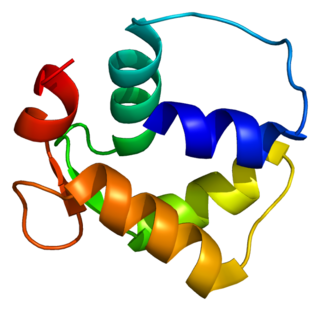
In cell biology, the centrosome is an organelle that serves as the main microtubule organizing center (MTOC) of the animal cell, as well as a regulator of cell-cycle progression. The centrosome provides structure for the cell. The centrosome is thought to have evolved only in the metazoan lineage of eukaryotic cells. Fungi and plants lack centrosomes and therefore use other structures to organize their microtubules. Although the centrosome has a key role in efficient mitosis in animal cells, it is not essential in certain fly and flatworm species.

Aurora kinase A also known as serine/threonine-protein kinase 6 is an enzyme that in humans is encoded by the AURKA gene.

Aurora kinase B is a protein that functions in the attachment of the mitotic spindle to the centromere.

Mitotic checkpoint serine/threonine-protein kinase BUB1 beta is an enzyme that in humans is encoded by the BUB1B gene. Also known as BubR1, this protein is recognized for its mitotic roles in the spindle assembly checkpoint (SAC) and kinetochore-microtubule interactions that facilitate chromosome migration and alignment. BubR1 promotes mitotic fidelity and protects against aneuploidy by ensuring proper chromosome segregation between daughter cells. BubR1 is proposed to prevent tumorigenesis.
In enzymology, a polo kinase is a kinase enzyme i.e. one that catalyzes the chemical reaction

Cell division cycle protein 27 homolog is a protein that in humans is encoded by the CDC27 gene.

Serine/threonine-protein kinase Nek2 is an enzyme that in humans is encoded by the NEK2 gene.

Centrin-2 is a protein that in humans is encoded by the CETN2 gene. It belongs to the centrin family of proteins.

Cell division cycle protein 16 homolog is a protein that in humans is encoded by the CDC16 gene.

Pericentrin (kendrin), also known as PCNT and pericentrin-B (PCNTB), is a protein which in humans is encoded by the PCNT gene on chromosome 21. This protein localizes to the centrosome and recruits proteins to the pericentriolar matrix (PCM) to ensure proper centrosome and mitotic spindle formation, and thus, uninterrupted cell cycle progression. This gene is implicated in many diseases and disorders, including congenital disorders such as microcephalic osteodysplastic primordial dwarfism type II (MOPDII) and Seckel syndrome.

Centrin-3 is a protein that in humans is encoded by the CETN3 gene. It belongs to the centrin family of proteins.

Centrosome-associated protein CEP250 is a protein that in humans is encoded by the CEP250 gene. This gene encodes a core centrosomal protein required for centriole-centriole cohesion during interphase of the cell cycle. The encoded protein dissociates from the centrosomes when parental centrioles separate at the beginning of mitosis. The protein associates with and is phosphorylated by NIMA-related kinase 2, which is also associated with the centrosome. Furthermore, CEP135 is also required for the centriolar localization of CEP250.

Centrosomal protein 170kDa, also known as CEP170, is a protein that in humans is encoded by the CEP170 gene.

Rootletin also known as ciliary rootlet coiled-coil protein (CROCC) is a protein that in humans is encoded by the CROCC gene. Rootletin is a component of the ciliary rootlet, and, together with CEP68 and CEP250, is required for centrosome cohesion.

Centrosomal protein of 192 kDa, also known as Cep192, is a protein that in humans is encoded by the CEP192 gene. It is the homolog of the C. elegans and D. melanogaster gene SPD-2.

Centrosomal protein of 164 kDa, also known as CEP164, is a protein that in humans is encoded by the CEP164 gene. Its function appears two be twofold: CEP164 is required for primary cilium formation. Furthermore, it is an important component in the response to DNA damage by UV light.

Centrosomal protein of 76 kDa, also known as CEP76, is a protein that in humans is encoded by the CEP76 gene.

Centrosomal protein of 78 kDa, also known as Cep78, is a protein that in humans is encoded by the CEP78 gene.

Centrosomal protein of 152 kDa, also known as Cep152, is a protein that in humans is encoded by the CEP152 gene. It is the ortholog of the Drosophila melanogaster gene asterless (asl) and both are required for centriole duplication.

Centrosomes are the major microtubule organizing centers (MTOC) in mammalian cells. Failure of centrosome regulation can cause mistakes in chromosome segregation and is associated with aneuploidy. A centrosome is composed of two orthogonal cylindrical protein assemblies, called centrioles, which are surrounded by a protein dense amorphous cloud of pericentriolar material (PCM). The PCM is essential for nucleation and organization of microtubules. The centrosome cycle is important to ensure that daughter cells receive a centrosome after cell division. As the cell cycle progresses, the centrosome undergoes a series of morphological and functional changes. Initiation of the centrosome cycle occurs early in the cell cycle in order to have two centrosomes by the time mitosis occurs.


















